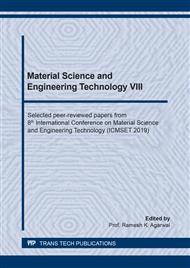p.203
p.209
p.215
p.221
p.227
p.233
p.239
p.246
p.255
The Effect of Sn(II) Precursor on Morphology and Surface Area of as Synthesis SnO2 Nanotube
Abstract:
Tin oxide nanotubes (STs) were synthesized by the hydrothermal process using manganese dioxide nanowires (MWs) as a template and followed by oxalic acid treatment. The effect of the stannous chloride concentration on the structure and crystallite size of the product were investigated. The phase composition was determined by XRD. Morphologies were revealed by FESEM and TEM. Firstly, manganese dioxide nanowires were fabricated from KMnO4. Then, tin oxide nanoparticles were coated on the wall surfaces of MWs templates. The template was then leached out by oxalic acid treatment. Nanotubular structure of the final product was formed by the agglomeration of the tin oxide nanoparticles coating on the template surfaces. On increasing the stannous chloride amount, crystallite size and the electrochemical properties increased, while the specific surface area decreased.
Info:
Periodical:
Pages:
227-232
Citation:
Online since:
June 2020
Keywords:
Price:
Сopyright:
© 2020 Trans Tech Publications Ltd. All Rights Reserved
Share:
Citation:


